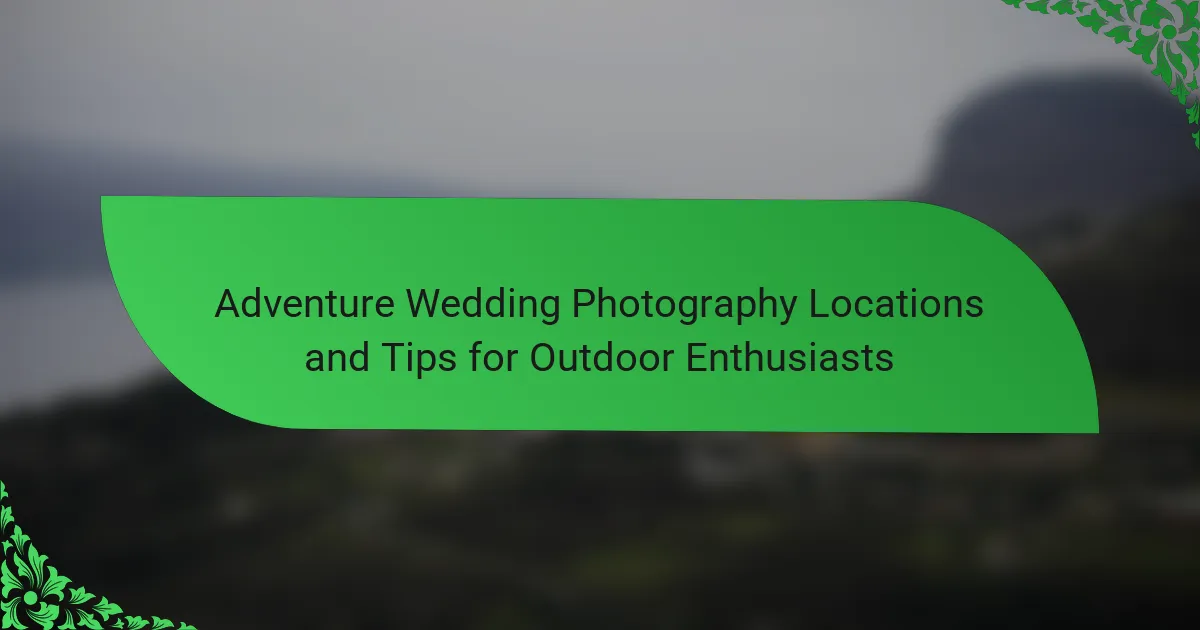Adventure wedding photography focuses on capturing couples in breathtaking outdoor locations such as national parks, mountains, beaches, and forests. Key locations include Yosemite National Park, Rocky Mountain National Park, Big Sur, and the Redwoods in California, each offering unique landscapes that enhance the wedding experience. The article provides essential tips for successful adventure wedding photography, including choosing stunning backdrops, utilizing natural light, capturing candid moments, and planning for unpredictable weather. Additionally, it addresses challenges such as remote locations, safety concerns, and logistical planning, emphasizing the importance of preparation and communication with couples to ensure memorable photography outcomes.

What are the Best Adventure Wedding Photography Locations?
The best adventure wedding photography locations include national parks, mountains, beaches, and forests. Locations like Yosemite National Park offer stunning backdrops with dramatic cliffs and waterfalls. The Rocky Mountain National Park features breathtaking mountain vistas and alpine lakes. Beaches such as Big Sur provide a beautiful coastal setting with rugged cliffs. Forests like the Redwoods in California create magical, intimate environments surrounded by towering trees. Each of these locations offers unique landscapes that enhance the adventure wedding experience.
How do you choose the perfect outdoor location for your wedding photography?
To choose the perfect outdoor location for wedding photography, evaluate the scenery and lighting. Scenic views enhance the visual appeal of wedding photos. Natural lighting is crucial for capturing vibrant images. Consider the time of day for optimal lighting conditions. Early morning or late afternoon provides soft, flattering light. Assess accessibility for the wedding party and guests. Locations should be easy to reach and safe. Check for permits or restrictions at specific sites. Some venues may require permissions for photography. Additionally, think about the season and weather conditions. Seasonal changes can dramatically affect the landscape. Finally, ensure the location reflects the couple’s personality and style. Personal connection to the site adds meaning to the photos.
What factors should you consider when selecting a location?
When selecting a location for adventure wedding photography, consider accessibility. The location should be reachable for both the couple and their guests. Evaluate the terrain and weather conditions. These factors can significantly impact the photography experience. Also, consider the scenery and backdrop. A visually stunning environment enhances the overall aesthetic of the photos. Look for unique features such as mountains, forests, or lakes. These elements can add depth to the images. Finally, check for permits and regulations. Some locations may require permission for photography activities.
How do different environments affect wedding photography?
Different environments significantly impact wedding photography. Each environment offers unique lighting, colors, and backdrops. For instance, outdoor settings provide natural light, which enhances image quality. Conversely, indoor venues may require artificial lighting for optimal results. Weather conditions also play a crucial role. Rain can create dramatic effects, while sunny days may lead to harsh shadows. The landscape influences composition and mood. Mountainous areas evoke a sense of adventure, while beaches convey tranquility. Ultimately, understanding these environmental factors allows photographers to capture the essence of the wedding day effectively.
What are some popular adventure wedding photography locations?
Some popular adventure wedding photography locations include national parks, mountain ranges, and coastal cliffs. National parks like Yosemite and Zion offer stunning backdrops. Mountain ranges such as the Rockies and the Alps provide dramatic scenery. Coastal cliffs, like those in Big Sur and the Amalfi Coast, create breathtaking ocean views. These locations are known for their natural beauty and diverse landscapes. Many couples choose these sites for their unique and picturesque settings. The variety of terrains enhances the photography experience. Each location offers distinct features that cater to adventurous couples.
Which national parks are ideal for wedding photography?
Yosemite National Park is ideal for wedding photography. It offers stunning landscapes, including granite cliffs and waterfalls. The iconic El Capitan and Half Dome provide breathtaking backdrops. Glacier National Park is another excellent choice. Its diverse scenery includes mountains, lakes, and forests. The vibrant colors of wildflowers enhance wedding photos. Zion National Park also stands out for its dramatic canyons and rock formations. The unique red sandstone creates a striking visual. Lastly, Grand Teton National Park features majestic peaks and serene lakes. The reflective waters add depth to wedding images. Each of these parks offers unique attributes that enhance the beauty of wedding photography.
What unique landscapes can enhance your wedding photos?
Unique landscapes that can enhance wedding photos include mountains, beaches, and forests. Mountain landscapes provide dramatic backdrops with stunning vistas. Beaches offer soft sand and beautiful sunsets, creating romantic settings. Forests feature lush greenery and natural light filtering through trees, adding a whimsical touch. Desert landscapes showcase unique textures and colors, offering a stark yet beautiful contrast. Waterfalls create dynamic scenes with flowing water, enhancing the visual appeal. Each of these landscapes contributes to memorable and striking wedding photography.
How do seasonal changes impact outdoor wedding photography locations?
Seasonal changes significantly impact outdoor wedding photography locations. Each season offers distinct lighting, colors, and weather conditions. Spring brings vibrant blooms and softer light, enhancing romantic settings. Summer offers lush greenery but may present harsh sunlight and heat. Autumn showcases stunning foliage, creating warm, colorful backdrops. Winter landscapes provide a serene, snowy ambiance, ideal for unique themes. These seasonal attributes can influence the choice of location, timing, and overall aesthetic of wedding photography. Photographers must adapt their techniques to leverage these seasonal characteristics effectively.
What are the best times of year for outdoor wedding photography?
The best times of year for outdoor wedding photography are spring and fall. Spring offers vibrant blooms and mild temperatures, ideal for picturesque settings. Fall provides stunning foliage and golden light, enhancing the overall aesthetic. Both seasons typically feature comfortable weather, which is favorable for outdoor events. Additionally, these times often have lower chances of rain compared to summer. In many regions, spring and fall also offer extended daylight hours, maximizing natural light for photography.
How can weather conditions influence your photography plans?
Weather conditions significantly influence photography plans by affecting lighting, mood, and accessibility. Overcast skies can provide diffused lighting, ideal for portraits and landscapes. Conversely, harsh sunlight can create strong shadows and highlight contrasts, complicating exposure settings. Rain can add drama and texture to images but may also necessitate protective gear for equipment. Windy conditions can disrupt stability and composition, particularly with outdoor setups. Additionally, extreme temperatures can impact equipment performance and the comfort of subjects. Photographers often check forecasts to plan for optimal shooting times and locations. For instance, the golden hour, just after sunrise or before sunset, offers the best natural light, which can be altered by weather changes.

What Tips Can Enhance Adventure Wedding Photography?
To enhance adventure wedding photography, consider the following tips. Choose locations with stunning backdrops like mountains or forests. Utilize natural light for better exposure and mood. Capture candid moments to reflect genuine emotions. Incorporate dynamic poses to showcase the adventurous spirit of the couple. Use wide-angle lenses to capture expansive landscapes. Plan for weather changes and have backup options ready. Scout locations in advance to identify the best angles. Communicate with the couple to understand their vision and preferences. These strategies improve the quality and impact of adventure wedding photography.
How can couples prepare for adventure wedding photography?
Couples can prepare for adventure wedding photography by selecting a suitable location that aligns with their adventurous spirit. They should research various outdoor venues that offer scenic backdrops, such as mountains, forests, or beaches. It is essential to choose a time of year that provides ideal weather conditions for outdoor photography. Couples should also consider hiring a photographer experienced in adventure wedding shoots to capture dynamic moments. Planning an itinerary that includes specific shots and activities can enhance the photography experience. Additionally, couples should prepare appropriate attire that suits the environment and allows for movement. Communicating with the photographer about their vision and expectations is crucial for achieving desired results. Finally, ensuring that all necessary permits and permissions are obtained for the chosen location is vital for a smooth experience.
What should you pack for an outdoor wedding shoot?
Pack essential photography gear for an outdoor wedding shoot. This includes a DSLR or mirrorless camera for high-quality images. Bring multiple lenses, such as a wide-angle for landscapes and a portrait lens for close-ups. Include extra batteries to ensure your camera remains powered throughout the event. Memory cards should be plentiful to store all captured moments. A sturdy tripod is important for stable shots, especially in low light. Weather protection gear, like rain covers for your camera, is crucial for unpredictable outdoor conditions. Lastly, pack a first aid kit for any minor injuries that may occur during the shoot.
How can you ensure a smooth photography experience on the day?
To ensure a smooth photography experience on the day, thorough planning is essential. Start by scouting the location in advance. Familiarity with the surroundings helps identify the best spots for photos. Prepare a detailed timeline for the day. This should include key moments and locations for shooting. Communicate this timeline with all involved parties. Clear communication reduces confusion and keeps everyone on track.
Check the weather forecast prior to the event. This allows for adjustments in plans if necessary. Ensure all equipment is ready and functioning. This includes cameras, lenses, and backup batteries. Having a checklist can prevent last-minute issues. Lastly, remain flexible and adaptable. Outdoor settings can be unpredictable, so a positive attitude helps manage unexpected changes.
What are the best practices for working with adventure wedding photographers?
Communicate your vision clearly with adventure wedding photographers. Discuss your preferred locations and styles beforehand. Provide a detailed timeline for the wedding day. This helps photographers plan for lighting and scenery. Be flexible with timing, especially for outdoor shoots. Weather can impact lighting and conditions. Consider a pre-wedding shoot to build rapport. This allows you to understand each other’s working styles. Share inspiration images to align expectations. This helps photographers capture your unique vision. Trust their expertise in challenging environments. Adventure photographers often have experience with unpredictable conditions.
How can you communicate your vision effectively?
To communicate your vision effectively, clearly articulate your ideas and goals. Use concise language to convey your message. Visual aids can enhance understanding. Engaging storytelling helps connect emotionally with your audience. Encourage feedback to ensure clarity. Regular updates keep everyone aligned with your vision. Research shows that clear communication increases project success rates by 25%.
What questions should you ask your photographer before the wedding?
What questions to ask your photographer before the wedding include inquiries about their experience with outdoor settings. Ask if they have a portfolio showcasing similar adventure weddings. Confirm their availability on your wedding date. Inquire about their approach to capturing candid moments versus posed shots. Discuss their backup plan for inclement weather. Clarify what equipment they will bring, especially for outdoor conditions. Confirm the number of hours of coverage included in their package. Lastly, ask about their editing style and timeline for receiving your photos. These questions ensure clarity and alignment with your expectations.
How can you incorporate adventure themes into your wedding photography?
Incorporating adventure themes into wedding photography involves capturing couples in dynamic settings and activities. Utilize outdoor locations like mountains, forests, or beaches to create a sense of adventure. Include action shots of the couple engaging in activities like hiking, kayaking, or climbing. Use natural lighting to enhance the scenery and create a vibrant atmosphere. Candid moments during these activities can evoke genuine emotions and excitement. Consider unique angles and perspectives to showcase the landscape and the couple’s connection. This approach not only highlights the adventure theme but also personalizes the couple’s story.
What creative ideas can make your photos stand out?
Utilize unique angles and perspectives to make your photos stand out. Experiment with low or high vantage points for dramatic effects. Incorporate natural elements like trees or rocks to frame your subjects. Use reflections in water for added depth and interest. Play with lighting during golden hour for warm, flattering tones. Capture candid moments to convey genuine emotions. Experiment with props that resonate with the adventure theme, such as backpacks or maps. Lastly, consider post-processing techniques to enhance colors and contrast for a more vibrant look.
How can you use props or activities to enhance your adventure theme?
Using props or activities can significantly enhance your adventure theme. Props like maps, compasses, and vintage suitcases create a sense of exploration. Activities such as hiking or climbing add excitement and engagement. Incorporating themed decor, like lanterns or rustic furniture, sets the mood. Unique elements, such as a bonfire or picnic setup, create memorable experiences. Engaging in fun activities, like zip-lining or kayaking, offers dynamic photo opportunities. These elements not only enrich the adventure theme but also create lasting memories. Studies show that immersive experiences lead to higher satisfaction and enjoyment during events.

What Challenges Might You Face in Adventure Wedding Photography?
Adventure wedding photography presents unique challenges. These challenges include unpredictable weather conditions, which can affect lighting and accessibility. Remote locations may require extensive travel and logistics planning. Limited access to amenities can hinder equipment setup and comfort. Safety concerns arise in rugged terrains, necessitating careful navigation. Additionally, time constraints can complicate capturing the perfect moments. Lastly, coordinating with couples and guests in dynamic settings can be difficult. Each of these factors requires careful consideration and preparation for successful adventure wedding photography.
What are common obstacles in outdoor wedding photography?
Common obstacles in outdoor wedding photography include unpredictable weather, challenging lighting conditions, and environmental distractions. Weather can change rapidly, affecting the comfort of the couple and guests. Rain or strong winds can disrupt planned shots. Lighting varies throughout the day, creating issues with harsh shadows or overexposed highlights. Natural elements, like trees or water, can interfere with framing and composition. Additionally, outdoor venues may have limited access to power sources for lighting equipment. These factors can complicate the photographer’s ability to capture the desired moments effectively.
How can you overcome unexpected weather challenges?
To overcome unexpected weather challenges, prepare by checking forecasts and packing appropriate gear. Always have backup plans for outdoor shoots. Use weather-resistant equipment to protect your gear. Consider alternative locations that provide shelter. Communicate with clients about potential weather issues in advance. Adjust shooting times to capture the best light during changing weather. Embrace the weather creatively; unique conditions can enhance photos. Historical data shows that many photographers find success shooting in varied weather, adding character to their work.
What should you do if your location becomes inaccessible?
If your location becomes inaccessible, first assess alternative routes or nearby locations. Use GPS or maps to find the best detours. Communicate with your team about the situation promptly. Adjust your schedule to accommodate travel delays. If necessary, consider rescheduling the shoot to a later date. Always have a backup location in mind for such situations. Research alternate sites ahead of time to ensure readiness. Being prepared can minimize disruptions during your adventure wedding photography.
How can you ensure safety during adventure wedding photography?
Ensure safety during adventure wedding photography by conducting thorough risk assessments. Identify potential hazards at the location, such as unstable terrain or extreme weather conditions. Use appropriate safety gear, including helmets and harnesses, when necessary. Communicate safety plans clearly with the couple and the wedding party. Maintain a first aid kit on-site for emergencies. Ensure that all equipment is secure and suitable for outdoor use. Familiarize yourself with local regulations regarding photography in specific locations. These steps help minimize risks and ensure a safe experience for everyone involved.
What precautions should you take in remote locations?
In remote locations, you should ensure safety and preparedness. Carry a comprehensive first aid kit for emergencies. Research the area for potential hazards like wildlife or unstable terrain. Inform someone of your itinerary and expected return time. Pack enough food and water for the duration of your stay. Use reliable navigation tools such as GPS or maps. Be aware of weather conditions and prepare for changes. Familiarize yourself with local emergency services and contact numbers. These precautions help mitigate risks associated with adventure activities in remote settings.
How can you prepare for potential risks associated with outdoor shoots?
To prepare for potential risks associated with outdoor shoots, conduct a thorough risk assessment beforehand. Identify environmental hazards like unstable terrain, extreme weather, and wildlife. Equip yourself with appropriate gear, including first aid kits and weather-appropriate clothing. Communicate with your team about safety protocols and emergency plans. Ensure all equipment is reliable and secure to prevent accidents. Familiarize yourself with the location and any permits needed. Stay updated on weather forecasts to avoid dangerous conditions. Lastly, have a backup plan in case of unforeseen circumstances.
What practical tips can help you succeed in adventure wedding photography?
To succeed in adventure wedding photography, prioritize planning and preparation. Research the location thoroughly before the event. Understand the terrain, weather conditions, and best lighting times. Communicate with the couple about their vision and preferences. Bring the right gear, including weather-resistant equipment and backup options. Utilize natural surroundings to create dynamic compositions. Stay flexible and adapt to changing conditions during the shoot. Build rapport with the couple to capture genuine emotions. These strategies enhance the overall quality of the photography and ensure a successful outcome.
How can you capture the essence of adventure in your photos?
To capture the essence of adventure in your photos, focus on dynamic composition and authentic moments. Use wide angles to emphasize landscapes and create a sense of scale. Incorporate movement by capturing subjects in action, such as hiking or jumping. Utilize natural light to enhance the mood and atmosphere of the scene. Select locations that evoke a sense of exploration, like mountains or forests. Experiment with different perspectives to add depth and intrigue. Candid shots often reveal genuine emotions, showcasing the thrill of the experience. These techniques collectively convey the adventurous spirit in photography.
What are the best techniques for photographing in natural light?
The best techniques for photographing in natural light include understanding the golden hour, using reflectors, and adjusting camera settings. The golden hour occurs shortly after sunrise and before sunset. During this time, the light is softer and warmer, enhancing colors and reducing harsh shadows. Using reflectors can help bounce light onto the subject, filling in shadows and creating a more balanced exposure. Adjusting camera settings, such as increasing the ISO or opening the aperture, can also optimize exposure in varying light conditions. These techniques are essential for capturing the beauty of outdoor settings in adventure wedding photography.
Adventure wedding photography focuses on capturing couples in stunning outdoor locations, such as national parks, mountains, beaches, and forests. Key factors for selecting ideal photography sites include accessibility, scenery, lighting, and seasonal considerations. The article outlines popular locations like Yosemite and Big Sur, offers tips for preparing for outdoor shoots, and addresses challenges such as weather conditions and safety in remote areas. Additionally, it provides practical advice for couples and photographers to enhance their experience and effectively communicate their vision.



